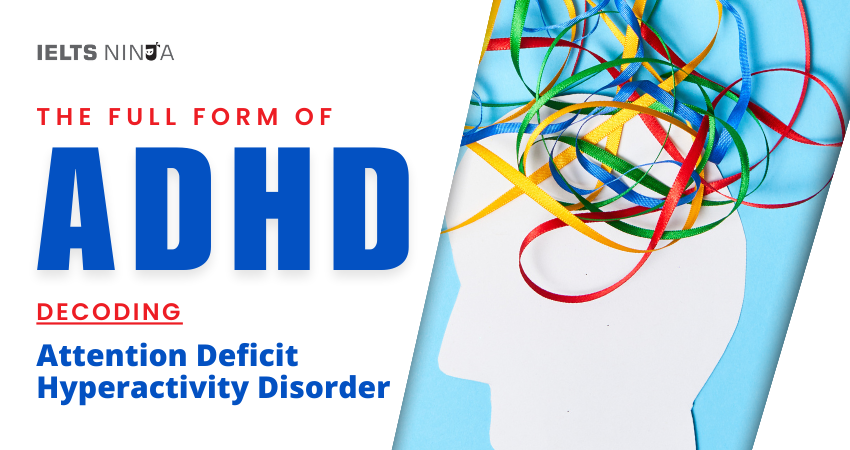The full form of ADHD stands for “Attention Deficit Hyperactivity Disorder”. It is a neurodevelopmental disorder that affects both children and adults. ADHD is characterized by persistent patterns of inattention, hyperactivity, and impulsivity that can significantly impact daily functioning and quality of life. In this guide, we will explore the details of ADHD, its symptoms, causes, diagnosis, and treatment options.
Key Details of ADHD:
The followings are the symptoms of ADHD:
Inattention:
- Difficulty in Sustaining Attention: Individuals with ADHD may struggle to focus on tasks, conversations, or activities, making frequent mistakes due to oversight.
- Easily Distracted: They are easily distracted by external stimuli, often losing track of what they were doing.
- Difficulty Organizing Tasks: Organizing and completing tasks, especially those that require sustained mental effort, can be challenging.
- Avoidance of Tasks Requiring Mental Effort: Individuals may avoid or delay tasks that require significant mental effort, such as schoolwork or paperwork.
Hyperactivity and Impulsivity:
- Restlessness: Constantly fidgeting, tapping, or moving about, even in situations where it’s not appropriate.
- Impulsiveness: Acting on impulses without considering the consequences, which can lead to accidents or social problems.
- Difficulty Waiting Turns: Finding it hard to wait in line, take turns, or wait for their chance in conversations.
- Intruding in Conversations or Games: Interrupting others, blurting out answers, and finishing people’s sentences.
Types of ADHD:
- Predominantly Inattentive Presentation: Characterized primarily by symptoms of inattention, with fewer hyperactivity-impulsivity symptoms.
- Predominantly Hyperactive-Impulsive Presentation: Characterized primarily by symptoms of hyperactivity and impulsivity, with fewer inattention symptoms.
- Combined Presentation: Involves a combination of both inattention and hyperactivity-impulsivity symptoms.
Causes and Risk Factors – ADHD:
The exact cause of ADHD is not known, but it is believed to result from a combination of genetic, environmental, and neurological factors. Risk factors may include:
- Genetics: ADHD tends to run in families, suggesting a genetic component.
- Brain Structure: Differences in brain structure and function, particularly in areas related to attention and impulse control, may play a role.
- Premature Birth: Being born prematurely or having low birth weight may increase the risk.
- Exposure to Toxins: Prenatal exposure to environmental toxins like lead may contribute.
- Brain Injury: Traumatic brain injury or certain neurological conditions can lead to ADHD-like symptoms.
Also Read: Best online IELTS coaching & training academy
Diagnosis – ADHD:
Diagnosing ADHD typically involves a comprehensive assessment by a healthcare professional, including:
- Clinical Interview: Gathering information about the individual’s symptoms, history, and behavior.
- Observation: Observing the person’s behavior in various settings, such as school and home.
- Rating Scales: Using standardized rating scales completed by parents, teachers, or the individual.
- Medical Evaluation: Ruling out other medical or psychological conditions that may mimic ADHD symptoms.
Treatment of ADHD:
- Behavioral Therapy: Therapy techniques, such as cognitive-behavioral therapy, can help individuals develop strategies to manage symptoms.
- Medication: Stimulant medications (e.g., methylphenidate or amphetamine-based drugs) and non-stimulant medications (e.g., atomoxetine) can be prescribed to manage symptoms. Medication decisions are individualized and should be made in consultation with a healthcare provider.
- Education and Support: Psychoeducation and support for individuals with ADHD and their families can help them better understand and cope with the condition.
- Lifestyle Strategies: Implementing practical strategies, such as time management, organization, and creating structured routines, can be beneficial.
Conclusion:
ADHD, or Attention Deficit Hyperactivity Disorder, is a neurodevelopmental disorder characterized by symptoms of inattention, hyperactivity, and impulsivity. It can have a significant impact on an individual’s life, including their academic, social, and occupational functioning. Early diagnosis and appropriate treatment, often involving a combination of therapy and medication, can help individuals with ADHD manage their symptoms and lead fulfilling lives.








